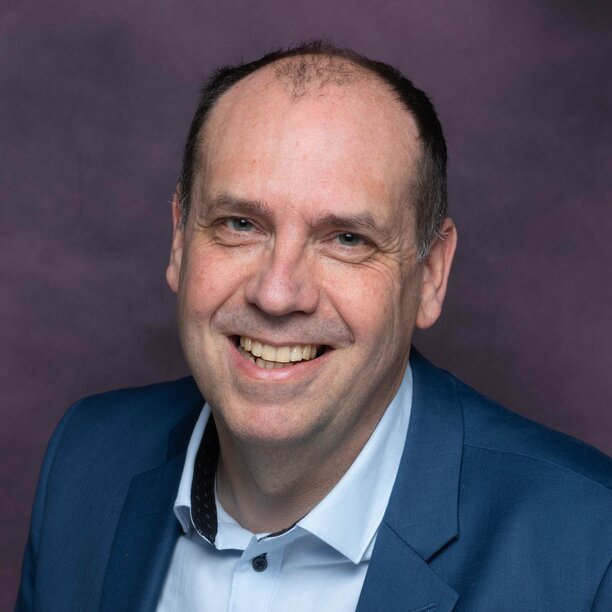Searching for synergies
After having worked at ‘Stichting Toekomstbeeld der Techniek’, FOM, NWO and the University of Amsterdam, in September 2021 Mark de Graef took up the position of Managing Director of TU/e’s Department of Chemical Engineering and Chemistry. He shares his observations on the relationship between the department and EIRES.
Though Eindhoven University of Technology is among the few that has disciplinary departments, daily practice for scientists at universities with broad science departments isn’t that different, De Graef observes. ‘Take the University of Amsterdam, where until recently I was Director Market Development & External Relations at the interdisciplinary science department. Yes, the department itself is broad, but within such a department each academic discipline tends to have its own institute. So in practice that isn’t that different from the situation here, where the departments are organized around individual disciplines, and the institutes bring them together.’
De Graef studied Chemistry and obtained his PhD in Microbiology at the University of Amsterdam. ‘What attracted me to my current position at TU/e is that there is room for me to be involved in in-depth discussions about chemistry-related issues and research strategy. And what I find very charming here is that the department is fairly small with a dedicated focus. We have a very high quality of research and a high turnover. Our researchers manage to acquire a lot of funding and prestigious grants.’
Balancing needs
The Department of Chemical Engineering and Chemistry is an important player in the energy transition, De Graef thinks. ‘We fully back the goals EIRES is pursuing. What I find challenging though is balancing the institute’s needs with the departmental strategy. Here in Eindhoven, I experience an open, warm, informal culture. The lines are short, all the way up to the Executive Board. Though that is very pleasant, it also has a downside: people tend to organize things ad hoc, via the informal route. That helps a lot in making things happen, but does not necessarily lead to the most coherent policies. Establishing a clear governance for the research institutes with respect to the departments is one of those things that could use some more attention.’
As a result, De Graef does experience some tension between the different organizational units, he admits. ‘For us as a department, it helps if EIRES marks a spot on the horizon. We can then see how our plans and people fit in.’ And such a concrete goal can also inspire new research, he says. ‘Take electrochemistry. For a long time, chemists weren’t keen on working on that, since the common idea was that it was an old technology we knew everything about. But now that we want to actually use electrochemistry at a large scale, it turns out that many interesting scientific questions are still unanswered.’
Not only in science, but also in industry defining concrete goals helps to set things in motion, De Graef illustrates with an example. ‘I usually refer to the story of how catalytic converters ended up in motor vehicles. That got an important impetus when the State of California back in the eighties issued legislation stating that within five years every newly produced vehicle had to be equipped with a catalytic converter. After initially saying that would be impossible, car manufacturers and scientists got together and within a short time developed the converters that did the job.’
Different roles to play
Asked about his vision on the role the energy institute should play, De Graef sums up several topics that come to mind. ‘First and foremost, I think these types of thematic institutes should set the scientific agenda on societal issues. So, define the big research themes at play, bring together the available expertise and knowhow on that topic, define blind spots, and facilitate larger scale, multidisciplinary research programs. And do not forget the other way around: the institutes should get inspired by interesting fundamental research at the different departments to define novel directions. Second, institutes like EIRES are perfectly positioned to act as a one stop shop for industrial partners. Industry usually struggles with questions that are not focused on one specific professor’s expertise or one scientific discipline. EIRES can bring together the right people and stimulate collaboration by facilitating joint research proposals.’
Not only when it comes to research, but also in the field of education de Graef sees opportunities for the institute. ‘EIRES could for example start developing dedicated master tracks, involving all of the necessary departments. Or help in defining possible topics of interest for new student teams.’ Taking the helicopter view to provide an overview of all of TU/e’s energy related activities is also something EIRES could take up, he thinks. ‘Why not develop catalogs that sum up all of the energy-related research and education activities that are currently taking place on campus. I think there is an extensive network, but it is still rather informal, mostly based on one-on-one connections, and it is too invisible.’
Provide incentives
As he experiences on a day-to-day basis, currently researchers are overloaded with work. ‘So they need a clear incentive if you want them to start up new collaborations with other departments. Back at the University of Amsterdam, they had specific budgets to stimulate such interdepartmental collaboration. And that works, as is evident from the current success of the Amsterdam AI initiatives, which got an important boost from that program.’
Meaningful collaborations start with a good joint plan with a clear aim, De Graef is convinced. ‘In that respect, I see a bright future for EIRES. The institute addresses an important and very relevant societal issue both government and industry are willing to invest in. With EIRES, we are joining forces to enlarge our innovation capacity in this field.’
